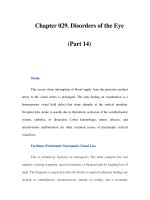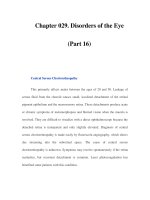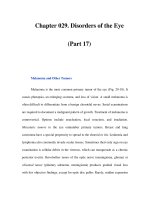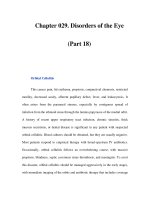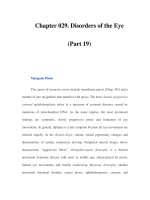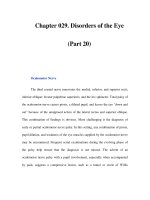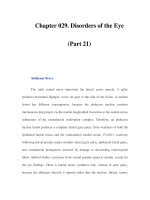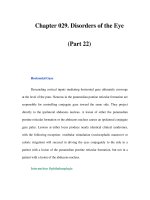Chapter 085. Neoplasms of the Lung (Part 16) doc
Bạn đang xem bản rút gọn của tài liệu. Xem và tải ngay bản đầy đủ của tài liệu tại đây (14.11 KB, 5 trang )
Chapter 085. Neoplasms of the Lung
(Part 16)
Chemotherapy
Chemotherapy palliates symptoms, improves the quality of life, and
improves survival in newly diagnosed patients with stage IV NSCLC, particularly
in patients with good performance status. Whereas the median survival for
untreated patients is roughly 4–6 months, and 1-year survival is 5–10%, with
combination chemotherapy the median survival is 8–10 months, 1-year survival is
30–35%, and 2-year survival 10–15%. Combination chemotherapy produces an
objective tumor response in 20–30% of patients, although the response is complete
in <5%. In addition, economic analysis has found chemotherapy to be cost-
effective palliation for stage IV NSCLC. However, the use of chemotherapy for
NSCLC requires clinical experience and careful judgment to balance potential
benefits and toxicities for these patients.
Chemotherapy for previously untreated, good-performance-status patients
typically consists of two drugs ("doublets"). Traditionally, one of the two drugs
has been either cisplatin or carboplatin, and the other drug is a taxane (paclitaxel
or docetaxel), gemcitabine, or a vinca alkaloid such as vinorelbine. No major
difference in outcome has been observed between the standard chemotherapy
doublets, although they differ in terms of schedule, side effects, and cost.
Cytotoxic chemotherapy for first-line chemotherapy is typically administered for
four to six cycles; no benefit has been shown for continuing the same
chemotherapy beyond that point. After four to six cycles, chemotherapy is usually
stopped and the patient observed closely for tumor progression, at which point
second-line chemotherapy may be started if the patient's performance status
remains good. Nausea with typical first-line regimens is usually mild, particularly
when 5-HT3 serotonin antagonists are used as antiemetics. Hair loss depends on
the choice of regimen and should be discussed with the patient. All regimens cause
myelosuppression, but the incidence of neutropenic fevers, bleeding episodes, or
anemia requiring transfusions is low. Growth-factor support is rarely needed.
Elderly patients without significant comorbid conditions benefit from and tolerate
chemotherapy much the same as their younger counterparts. However, patients
with a poorer performance status seem to obtain less benefit.
Docetaxel and pemetrexed are second-line agents for patients who have
progressive disease on first-line chemotherapy and still have a good performance
status. Docetaxel improves progression-free survival and overall survival
compared to best supportive care, and pemetrexed has roughly the same efficacy
as docetaxel, but with fewer side effects.
VEGF Targeted Therapy
Bevacizumab, a monoclonal antibody to VEGF, improves response rate,
progression-free survival, and overall survival of patients with advanced disease
when combined with chemotherapy (paclitaxel/carboplatin). Median, 1-year, and
2-year survival in response to chemotherapy plus bevacizumab was 12.3 months,
51%, and 23%, compared, respectively, to 10.3 months, 44%, and 15% with
chemotherapy alone (hazard ratio 0.79, p = 0.003). A 1-year survival of >50% and
a 2-year survival of >20% represents a significant improvement in long-term
prognosis. The dose of bevacizumab administered on this trial was 15 mg/kg IV
every 3 weeks. Bevacizumab side effects include bleeding, hypertension, and
proteinuria, and the hemorrhagic side effects make this agent risky to use. Patients
with squamous cancer cannot receive bevacizumab because of their tendency
toward serious hemorrhagic side effects. Patients with brain metastases,
hemoptysis, and bleeding disorders or who need anticoagulation are also not
eligible to receive the agent. Despite these restrictions and careful patient
selection, significant bleeding is noted in about 4% of patients.
EGFR Targeted Therapy
Erlotinib is an oral inhibitor of the EGFR kinase that is used in second- and
third-line therapy of NSCLC. Clinical responses have been seen in a large fraction
of the small subset of patients with tumors bearing mutations in the EGFR.
Prolonged survival with EGFR TKI treatment has also been observed in some
patients whose tumors have amplification of the EGFR gene or overexpression of
the receptor. Side effects of erlotinib differ from chemotherapy side effects of hair
loss, nausea, and neutropenia, but they include acneiform skin rash and diarrhea.
For patients whose tumors respond to EGFR TKI therapy, substantial clinical
benefit is seen.
Small Cell Lung Cancer
SCLC is a chemotherapy-sensitive disease. Patients with limited stage
disease have high response rates (60–80%) and a 10–30% complete response rate.
The response rates in patients with extensive disease are somewhat lower (50%)
and almost always partial responses. Tumor regressions usually occur quickly,
within the first two cycles of treatment, and provide rapid palliation of tumor-
related symptoms.
Chemotherapy significantly prolongs survival. Untreated, patients with
limited-stage SCLC have a median survival of 12 weeks; the median survival with
chemotherapy is 18 months, and long-term (>3 year) survival is 30–40%. The
median survival of extensive-stage patients is 9 months; <5% of patients survive 2
years. Thus, although initially responsive, most patients with SCLC relapse,
presumably due to the emergence of chemotherapy resistance.

